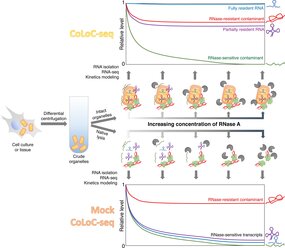Damien Jeandard, Anna Smirnova, Akinyemi Mandela Fasemore, Léna Coudray, Nina Entelis, Konrad U Förstner, Ivan Tarassov, Alexandre Smirnov (2023) CoLoC-seq probes the global topology of organelle transcriptomes. Nucleic Acids Research 51:e16.
Proper RNA localisation is essential for physiological gene expression. Various kinds of genome-wide approaches permit to comprehensively profile subcellular transcriptomes. Among them, cell fractionation methods, that couple RNase treatment of isolated organelles to the sequencing of protected transcripts, remain most widely used, mainly because they do not require genetic modification of the studied system and can be easily implemented in any cells or tissues, including in non-model species. However, they suffer from numerous false-positives since incompletely digested contaminant RNAs can still be captured and erroneously identified as resident transcripts. Here we introduce Controlled Level of Contamination coupled to deep sequencing (CoLoC-seq) as a new subcellular transcriptomics approach that efficiently bypasses this caveat. CoLoC-seq leverages classical enzymatic kinetics and tracks the depletion dynamics of transcripts in a gradient of an exogenously added RNase, with or without organellar membranes. By means of straightforward mathematical modelling, CoLoC-seq infers the localisation topology of RNAs and robustly distinguishes between genuinely resident, luminal transcripts and merely abundant surface-attached contaminants. Our generic approach performed well on human mitochondria and is in principle applicable to other membrane-bounded organelles, including plastids, compartments of the vacuolar system, extracellular vesicles, and viral particles.

